Classification of Elastic Wave for Non-Destructive Inspections Based on Self-Organizing Map
Abstract
1. Introduction
2. SOM Analysis
2.1. Architecture of SOM
2.2. Classification of Elastic Waves
3. Experimental Set Up
3.1. Artificial AE Measurement Conditions
3.2. Arrival Time Detection
3.3. Validation of the Classification Using SOM
3.4. AE Source Localization with the Classfied Artifical AE Signals
4. Results
4.1. Results of the Classification Using SOM
4.2. Results of AE Source Localization with Classified Artificial AE Signals
5. Discussion
6. Conclusions
- According to Figure 12, in each sensor, the number of the measured waves belonged to the high and low S/N class is totally 10 times and the number is the same as the number of PLB test times. Therefore, it was confirmed that the classification based on SOM can performs to classify artificial AE signals and noises from measurement data.
- In this classification, waveforms were not directly applied to input vectors and 3-dimensions input vectors in which components were consisted of the root mean square voltage obtained from the equally divided waveform were used. According to the results of SOM, it was confirmed that artificial AE signals were classified by 3-dimentions input vectors computed based on the root mean square voltage.
- The AE source localization based on ray-tracing was conducted with classified waves. As consequence, the localized sources were more accurate in comparison with the use of all waves. Therefore, if the measurement data include several noises because the measurement trigger is not appropriate for measurement conditions, the SOM performs to eliminate noises and it implies that the dependency of the measurement trigger in the accuracy of measurements is improved.
- The accuracy of the source localization with classified waves in homogeneous velocity distributions were approximated the results of the source localization considered heterogeneous velocity distributions. Therefore, it is expected that the source localization in heterogeneous velocity distributions does not require considering the diffractions caused by the heterogeneity of the material if classified waves are used in the source localization.
- According to Figure 13, the classification based on SOM performed to visualize 3 of classes with a limited number of waves. In addition, the AE source localization was improved by the accurate arrival times detected from the waveforms classified by the formed high S/N class. Hence, it was confirmed that a result of SOM is possible to be applied to other measurement data if the data are measured in the same conditions as forming the map. Therefore, it is expected that the computation cost can be more conserved in comparison with conducting SOM in each measurement if the formed map is shared in each measurement.
- In Figure 13, the high S/N class included diffraction waves, and it is expected that the classified diffraction waves are larger S/N in comparison with other diffraction waves. Thus, the classified diffraction wave has potential to be detected accurate arrival times. However, applied AR-AIC detected arrival times of the diffraction waves including detection errors. Therefore, it is expected that other arrival time detection method in which has the potential to detect arrival times from diffraction waves, is required to be applied to the classified waves in order to identify an accurate velocity distribution by the tomography methods.
Author Contributions
Funding
Institutional Review Board Statement
Informed Consent Statement
Data Availability Statement
Conflicts of Interest
References
- Carabelli, E.; Federici, P.; Graziano, F.; Rondena, E.; Zaninetti, A. Location of ae sources in the rock foundation of the passante dam. Eng. Fract. Mech. 1990, 35, 599–606. [Google Scholar] [CrossRef]
- Manuello, A.; Gianni, N.; Carpinteri, A. AE monitoring of a concrete arch road tunnel: Damage evolution and localization. Eng. Fract. Mech. 2019, 210, 279–287. [Google Scholar] [CrossRef]
- Sassa, K. Suggested for seismic testing within and between boreholes. Int. J. Rock Mech. Min. Sci. Geomech. Abstr. 1988, 25, 447–472. [Google Scholar] [CrossRef]
- Kobayashi, Y.; Shiotani, T. Innovative AE and NDT Techniques for On-Site Measurement of Concrete and Masonry Structures: State-of-the-Art Report of the RILEM Technical Committee 239-MCM, 1st ed.; Ohtsu, M., Ed.; Springer: Dordrecht, The Netherlands, 2016; pp. 47–68. [Google Scholar]
- Chai, H.K.; Liu, K.F.; Behnia, A.; Kobayashi, Y.; Shiotani, T. Development of a tomography technique for assessment of the material condition of concrete using optimized elastic wave parameters. Materials 2016, 9, 291. [Google Scholar] [CrossRef]
- Shiotani, T.; Osawa, S.; Kobayashi, Y.; Momoki, S. Application of 3D AE tomography for triaxial tests of rocky specimens. In Proceedings of the 31st Conference of the European Working Group on Acoustic Emission, Dresden, Germany, 3–5 September 2014. [Google Scholar]
- Lockner, D. The role of acoustic emission in the study of rock fracture. Int. J. Rock Mech. Min. Sci. Geomech. Abstr. 1993, 30, 883–899. [Google Scholar] [CrossRef]
- Yun, H.D.; Choi, W.C.; Seo, S.Y. Acoustic emission activities and damage evaluation of reinforced concrete beams strengthened with CFRP sheets. NDT E Int. 2010, 43, 615–628. [Google Scholar] [CrossRef]
- Ohno, K.; Uji, K.; Ueno, A.; Ohtsu, M. Fracture process zone in notched concrete beam under three-point bending by acoustic emission. Constr. Build. Mater. 2014, 67, 139–145. [Google Scholar] [CrossRef]
- Baer, M.; Kradolfer, U. An automatic phase picker for local and teleseismic events. Bull. Seismol. Soc. Am. 1987, 77, 1437–1445. [Google Scholar] [CrossRef]
- Lokajíček, T.; Klíma, K. A first arrival identification system of acoustic emission (AE) signals by means of a high-order statistics approach. Meas. Sci. Technol. 2006, 17, 2461. [Google Scholar] [CrossRef]
- Takanami, T.; Kitagawa, G. A new efficient procedure for the estimation of onset times of seismic waves. J. Phys. Earth 1988, 36, 267–290. [Google Scholar] [CrossRef]
- Sedlak, P.; Hirose, Y.; Enoki, M. Acoustic emission localization in thin multi-layer plates using first-arrival determination. Mech. Syst. Signal Process. 2013, 36, 636–649. [Google Scholar] [CrossRef]
- Physical Acoustics Corporation. AEwin Software User’s Manual, Express-8 AE System; Physical Acoustics Corporation: Princeton, NJ, USA, 2014. [Google Scholar]
- Wenli, L.; Liu, A.; Mao, W.; Koseki, J. Acoustic emission behavior of granular soils with various ground conditions in drained triaxial compression tests. Soils Found. 2020, 60, 929–943. [Google Scholar] [CrossRef]
- Dong, L.; Tao, Q.; Hu, Q.; Deng, S.; Chen, Y.; Luo, Q.; Zhang, X. Acoustic emission source location method and experimental verification for structures containing unknown empty areas. Int. J. Min. Sci. Technol. 2022, 32, 487–497. [Google Scholar] [CrossRef]
- Huang, J.; Qin, C.Z.; Niu, Y.; Li, R.; Song, Z.; Wang, X. A method for monitoring acoustic emissions in geological media under coupled 3-D stress and fluid flow. J. Pet. Sci. Eng. 2022, 211, 110227. [Google Scholar] [CrossRef]
- Kohonen, T. Essentials of the self-organizing map. Neural Netw. 2013, 37, 52–65. [Google Scholar] [CrossRef]
- Godin, N.; Huguet, S.; Gaertner, R. Integration of the Kohonen’s self-organising map and k-means algorithm for the segmentation of the AE data collected during tensile tests on cross-ply composite. NDT E Int. 2005, 38, 299–309. [Google Scholar] [CrossRef]
- Bhuiyan, M.A.H.; Karmaker, S.C.; Saha, B.B. Nexus between potentially toxic elements’ accumulation and seasonal/anthropogenic influences on mangrove sediments and ecological risk in Sundarbans, Bangladesh: An approach from GIS, self-organizing map, conditional inference tree and random forest models. Environ. Pollut. 2022, 309, 119765. [Google Scholar] [CrossRef]
- Rasti, J.; Monadjemi, A.; Vafaei, A. Color reduction using a multi-stage Kohonen Self-Organizing Map with redundant features. Expert Syst. Appl. 2011, 38, 13188–13197. [Google Scholar] [CrossRef]
- Vesanto, J.; Himberg, J.; Alhoniemi, E.; Parhankangas, J. Self-organizing map in Matlab: The SOM Toolbox. In Proceedings of the Matlab DSP Conference, Espoo, Finland, 16–17 November 1999. [Google Scholar]
- Xiao, D.; He, T.; Pan, Q.; Liu, X.; Wang, J.; Shan, Y. A novel acoustic emission beamforming method with two uniform linear arrays on plate-like structures. Ultrasonics 2014, 54, 737–745. [Google Scholar] [CrossRef]
- Mirgal, P.; Pal, J.; Banerjee, S. Online acoustic emission source localization in concrete structures using iterative and evolutionary algorithms. Ultrasonics 2020, 108, 106211. [Google Scholar] [CrossRef]
- Tian, H.; Qiang, P.; Xiandong, L.; Yingchun, S. AE beamforming method for damage inspection of aircraft structures. Procedia Eng. 2011, 17, 297–302. [Google Scholar] [CrossRef]
- Nakamura, K.; Kobayashi, Y.; Oda, K.; Shigemura, S.; Ikebata, K. Validation of elastic wave arrival detection method based on use of sparse matrix computation. IOP Conf. Ser. Mater. Sci. Eng. 2022, 1242, 012025. [Google Scholar] [CrossRef]
- Ai, L.; Soltangharaei, V.; Bayat, M.; Greer, B.; Ziehl, P. Source localization on large-scale canisters for used nuclear fuel storage using optimal number of acoustic emission sensors. Nucl. Eng. Des. 2021, 375, 111097. [Google Scholar] [CrossRef]
- Mao, W.; Goto, S.; Towhata, I. A study on particle breakage behavior during pile penetration process using acoustic emission source location. Geosci. Front. 2020, 11, 413–427. [Google Scholar] [CrossRef]
- Kobayashi, Y. Mesh-independent ray-trace algorithm for concrete structure. Constr. Build. Mater. 2013, 48, 1309–1317. [Google Scholar] [CrossRef]
- Kundu, T. Acoustic source localization. Ultrasonics 2014, 54, 25–38. [Google Scholar] [CrossRef]
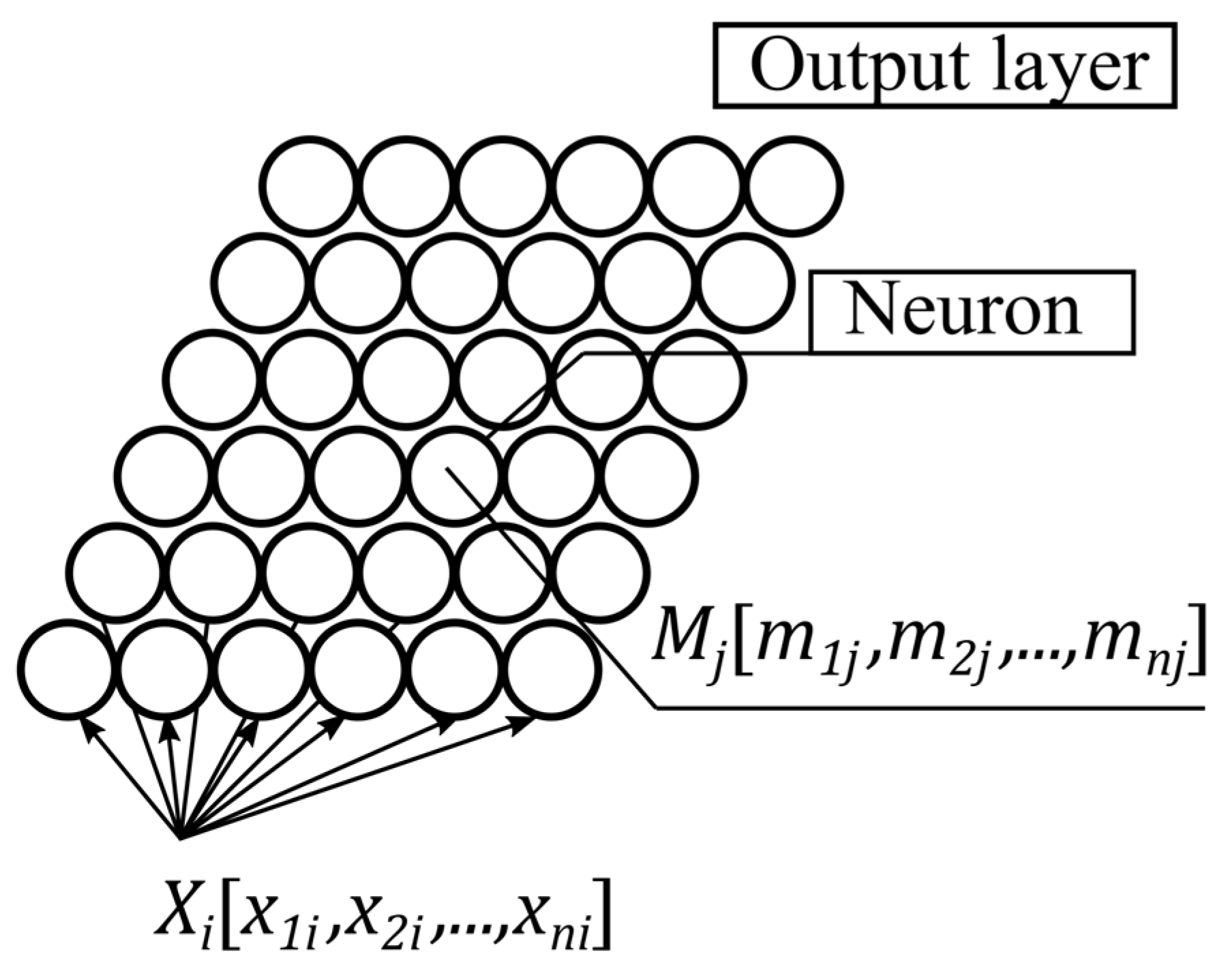
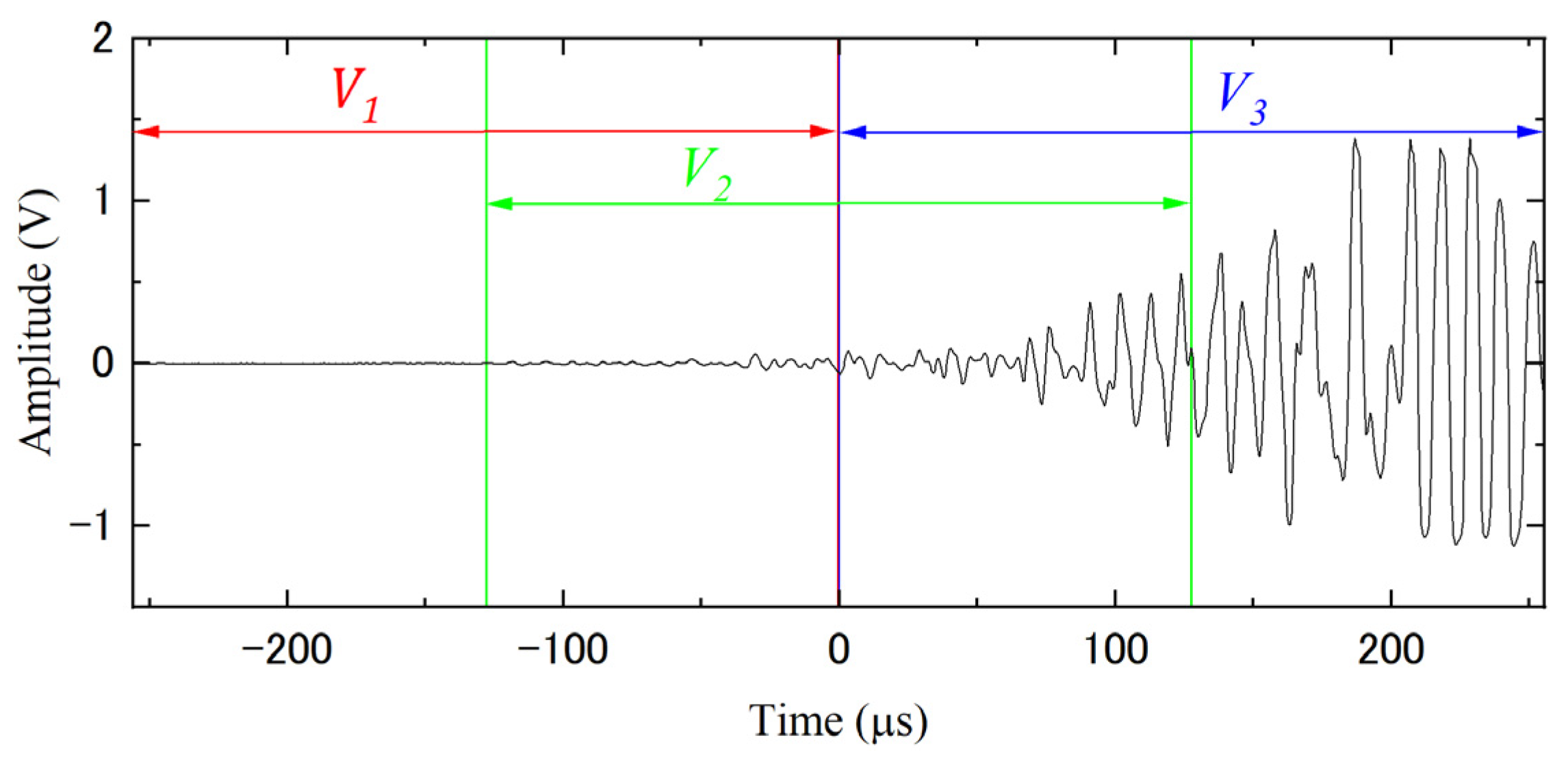


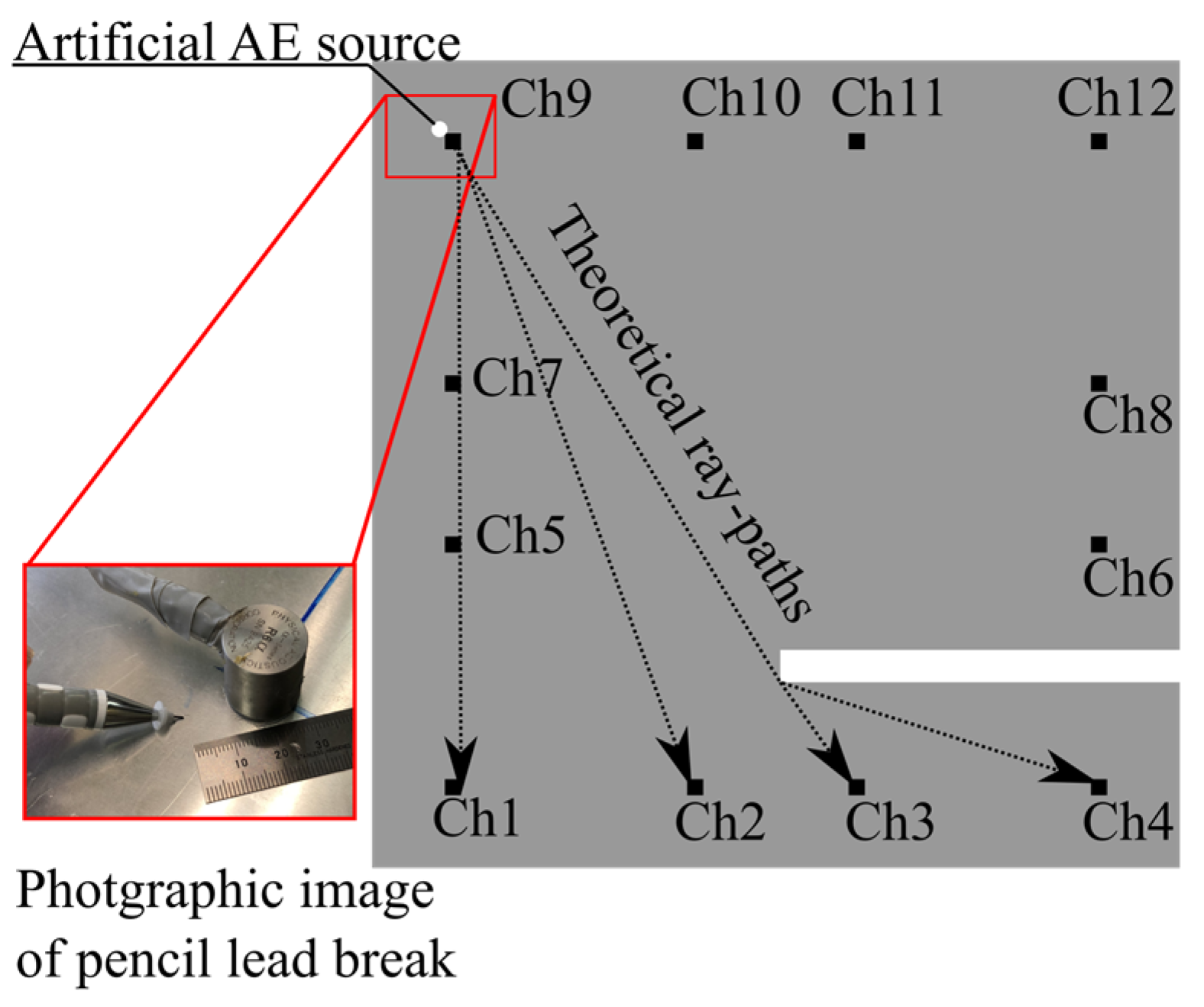
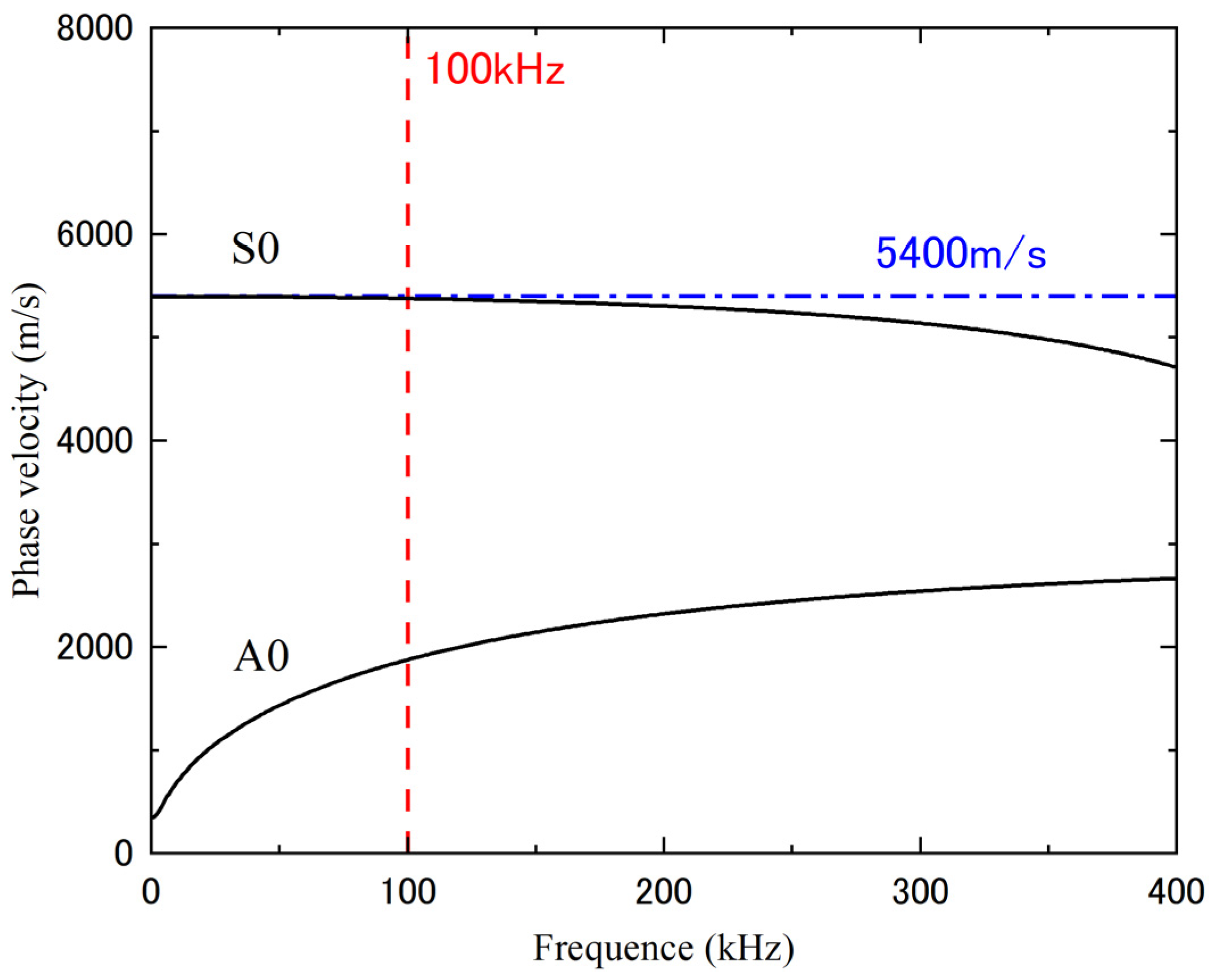
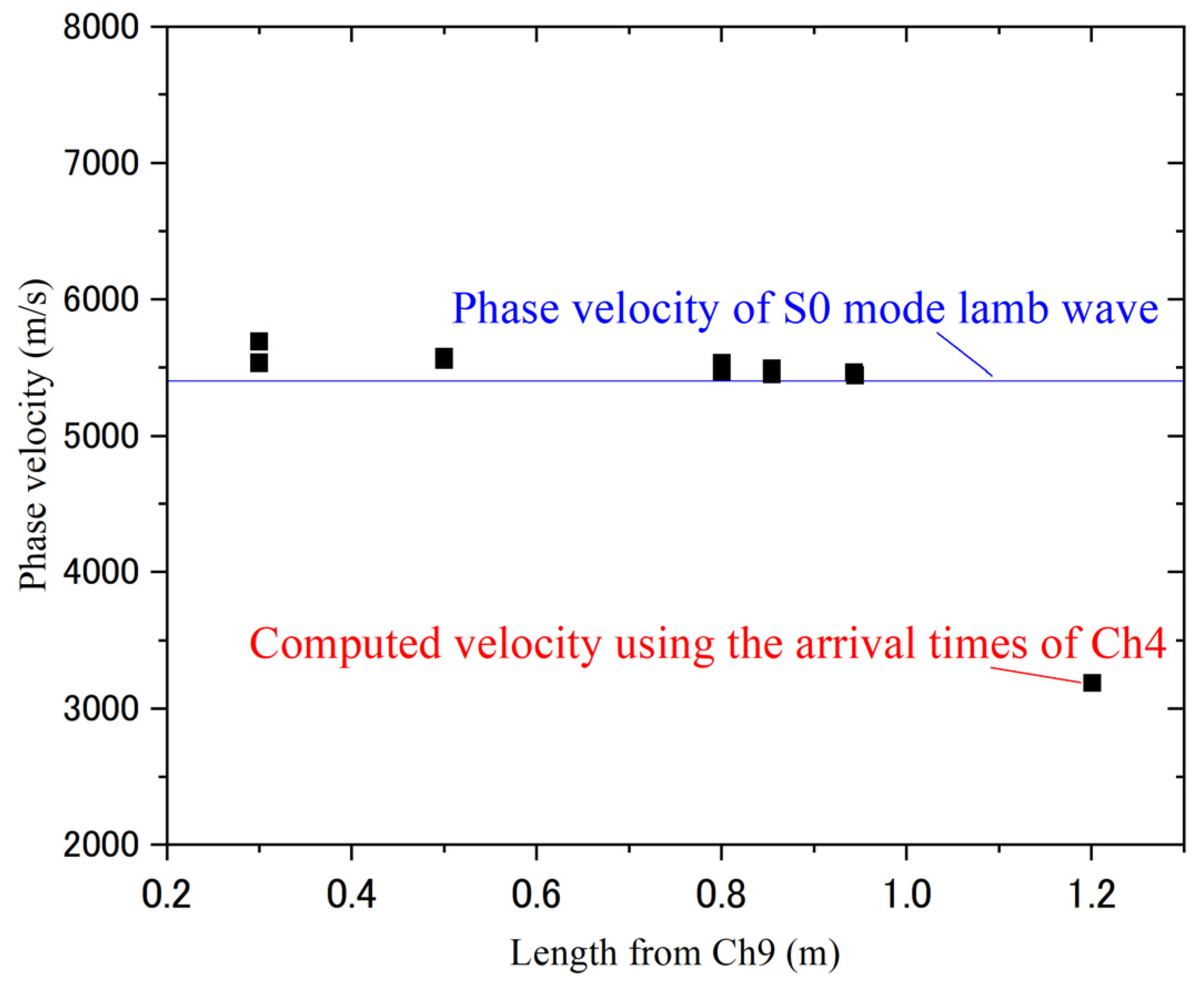


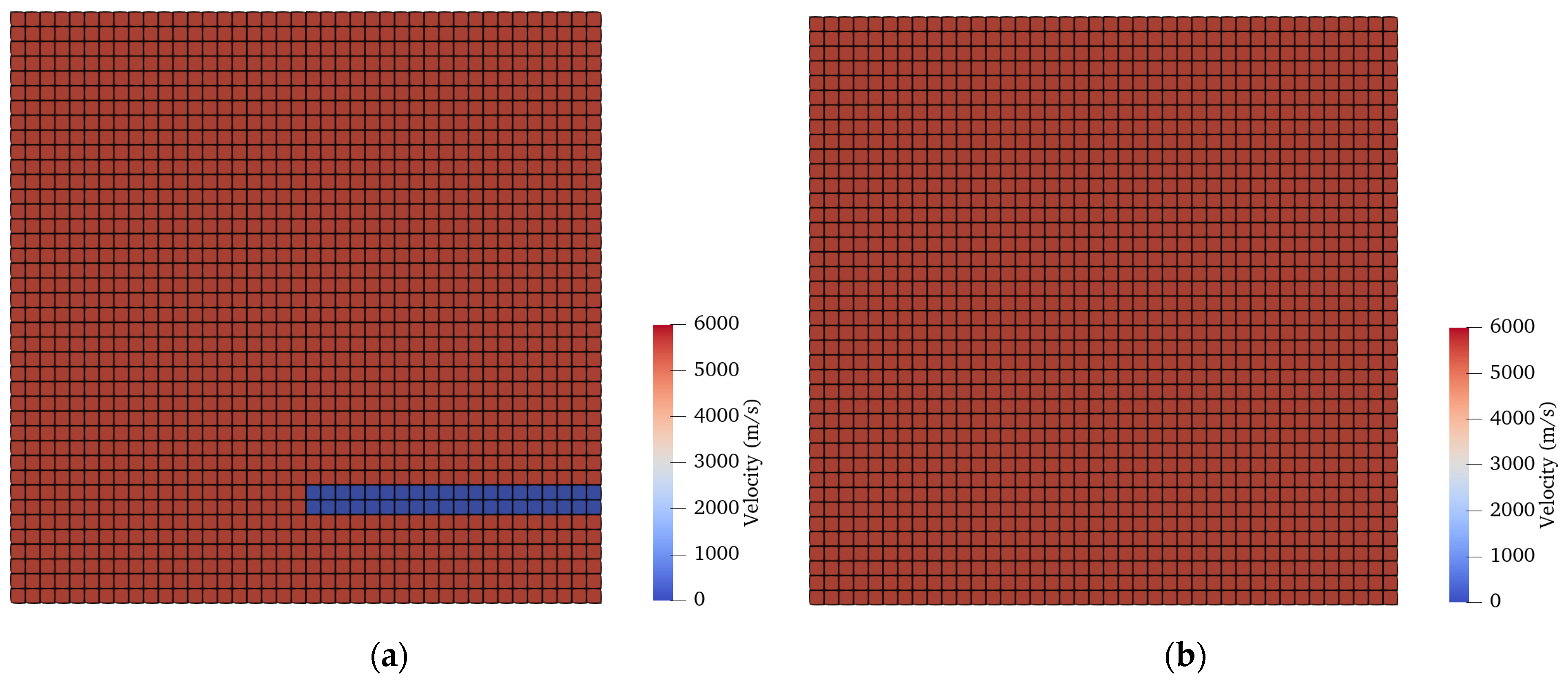
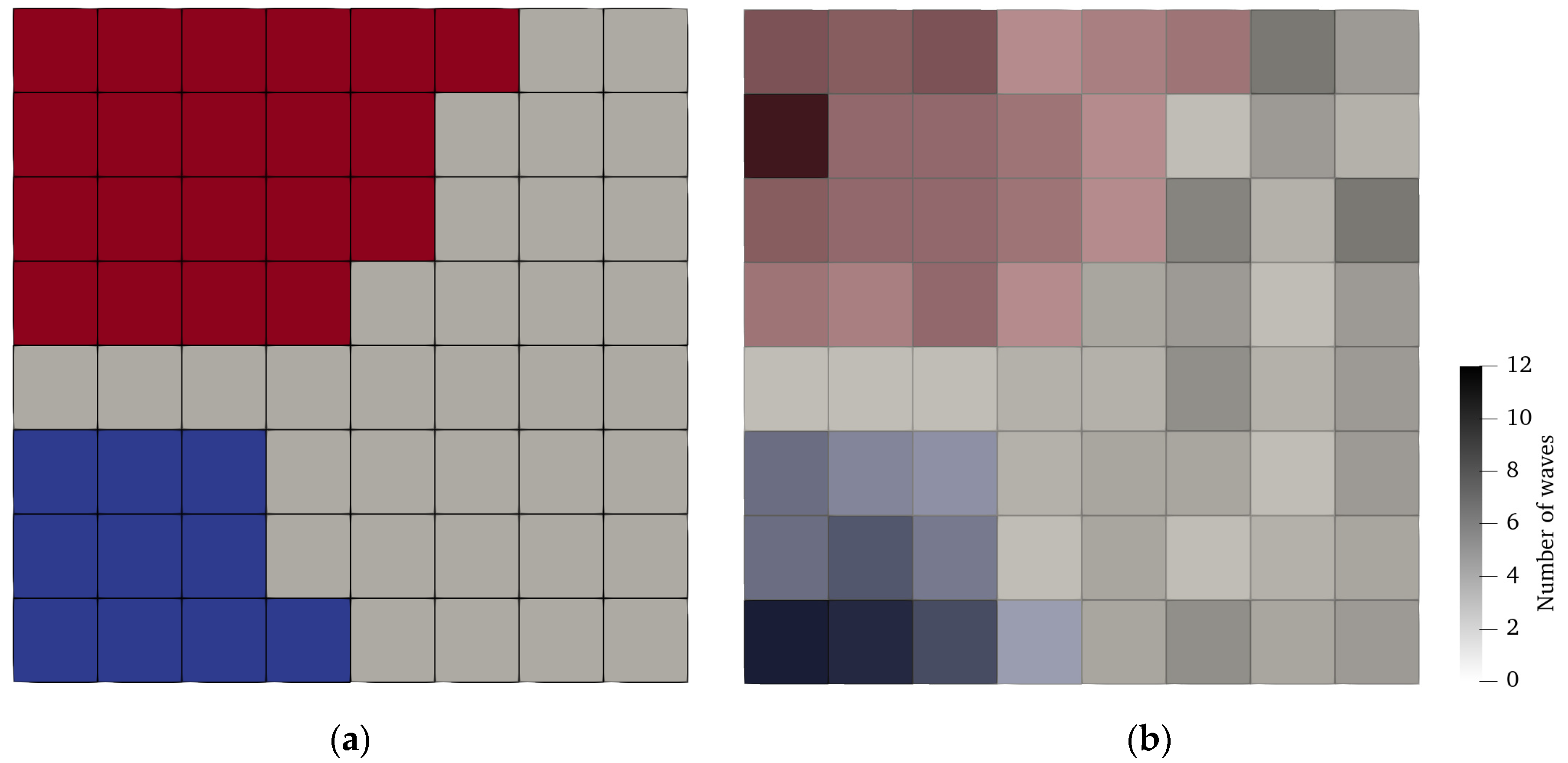
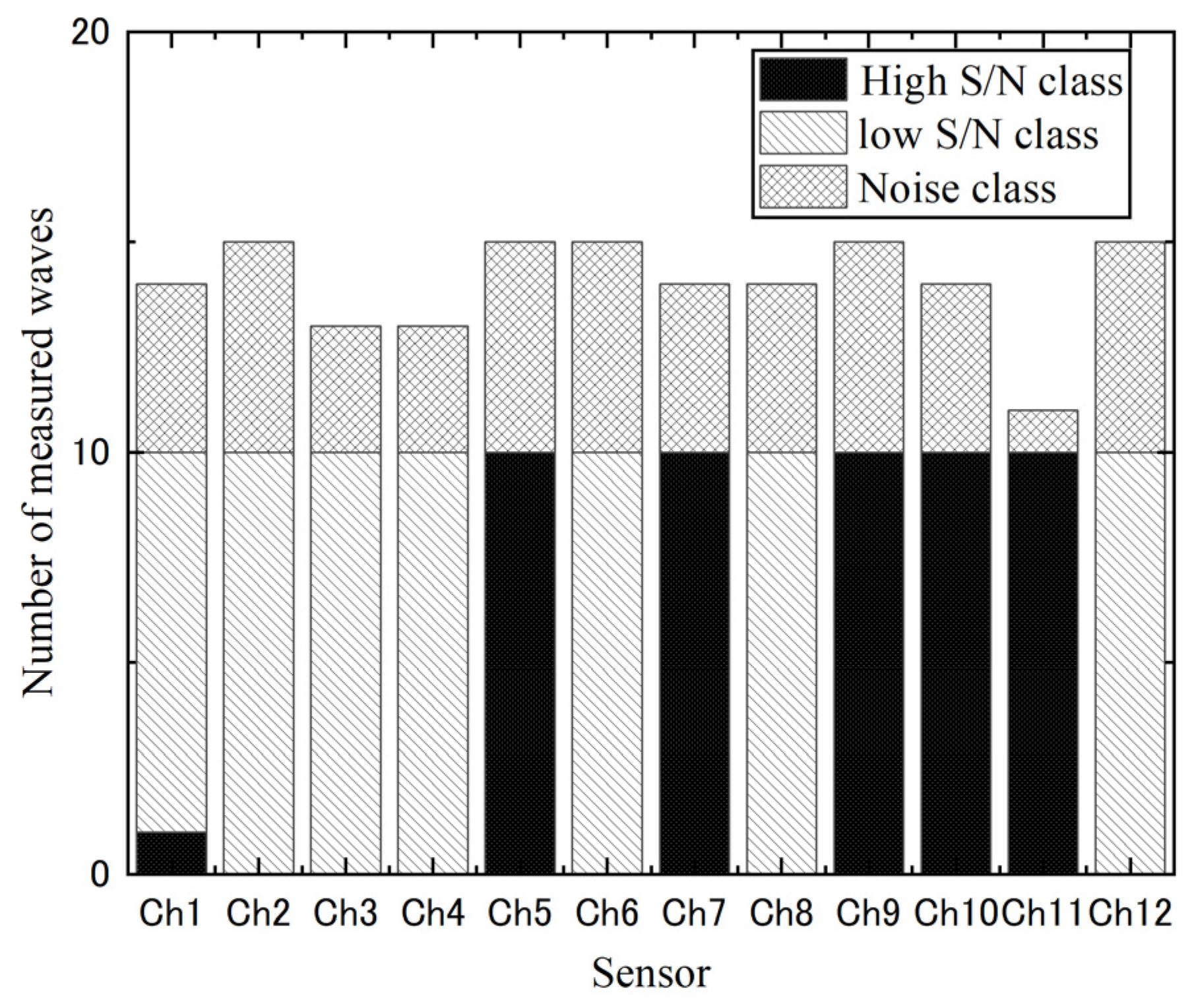
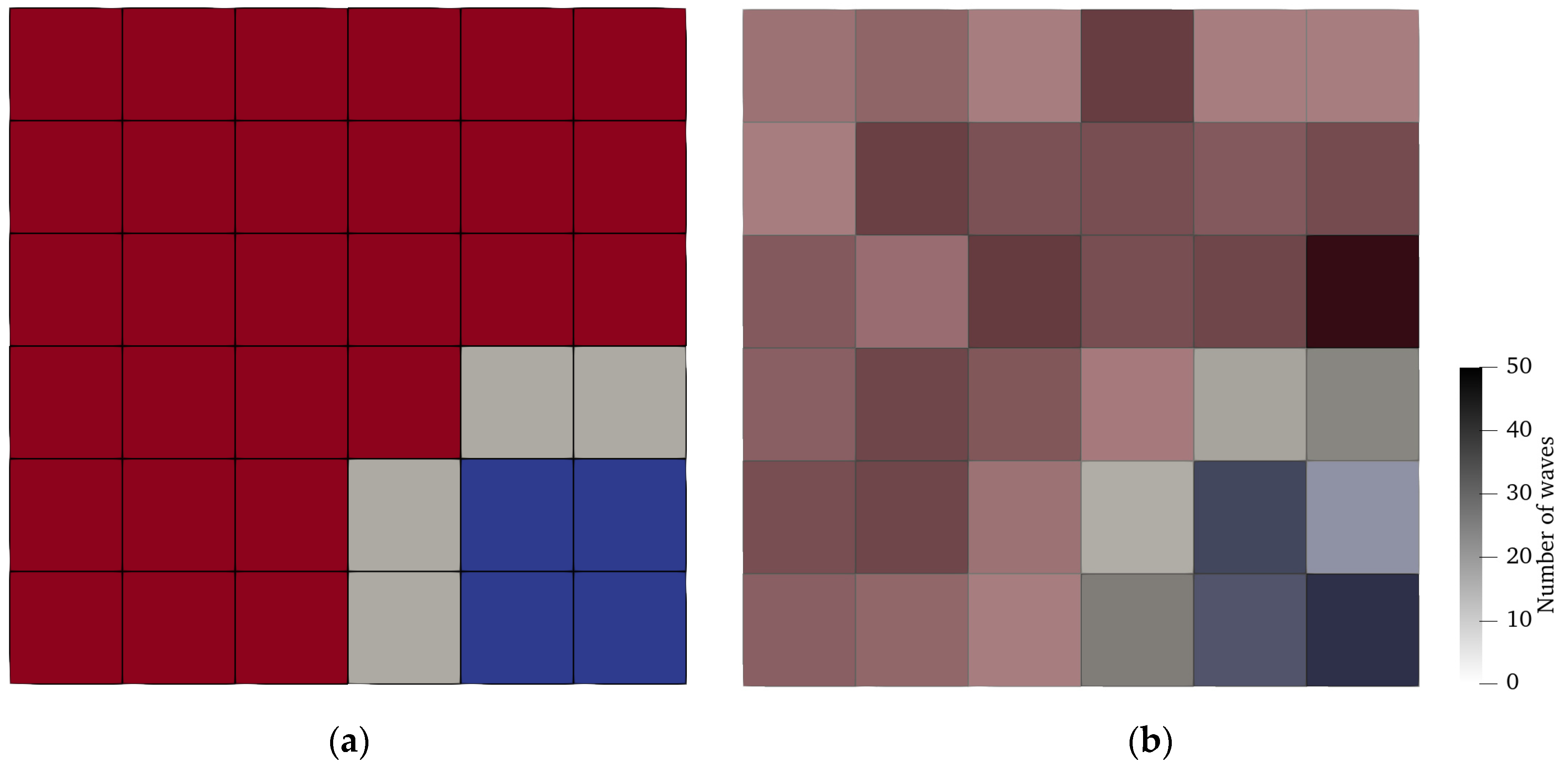
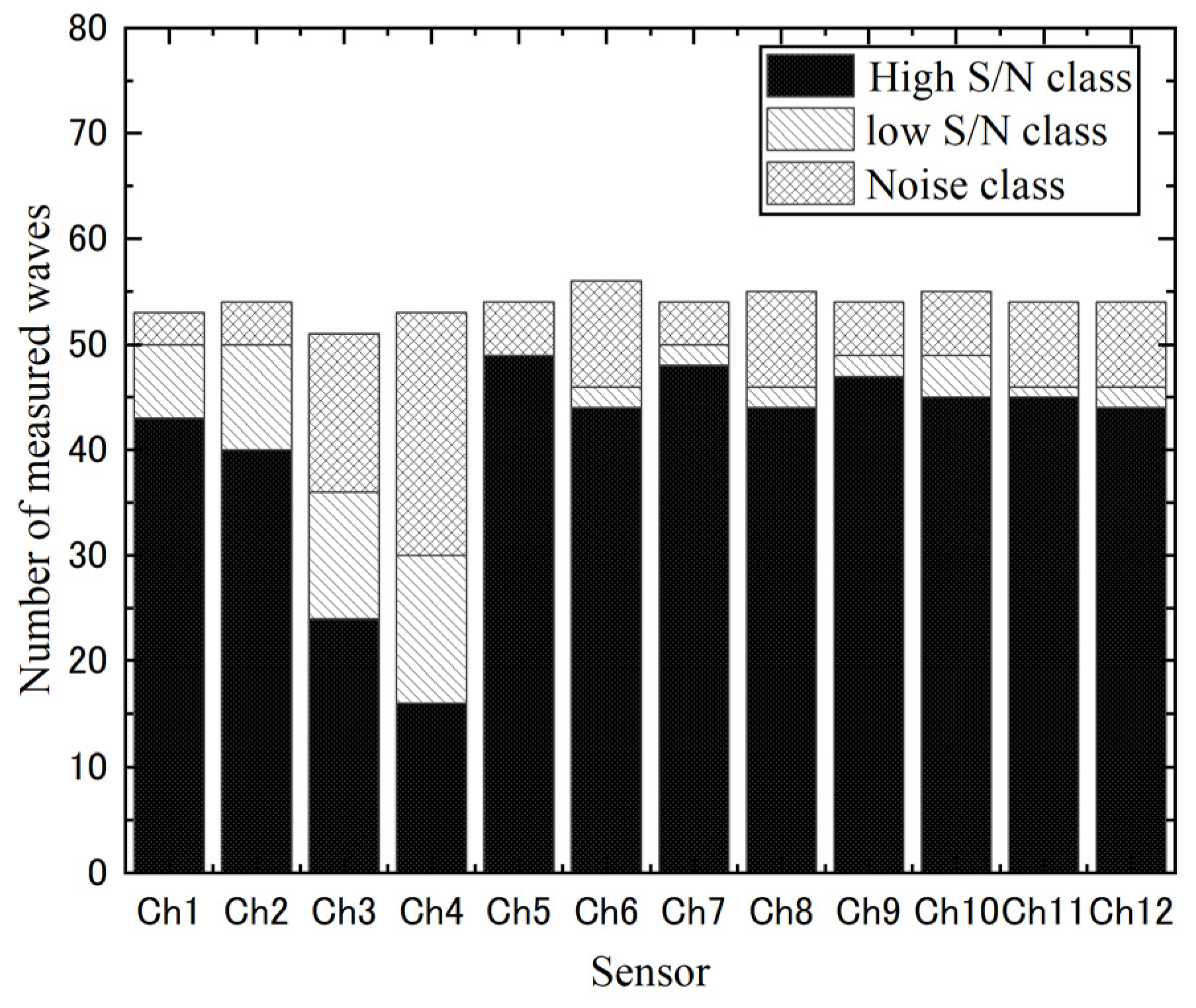

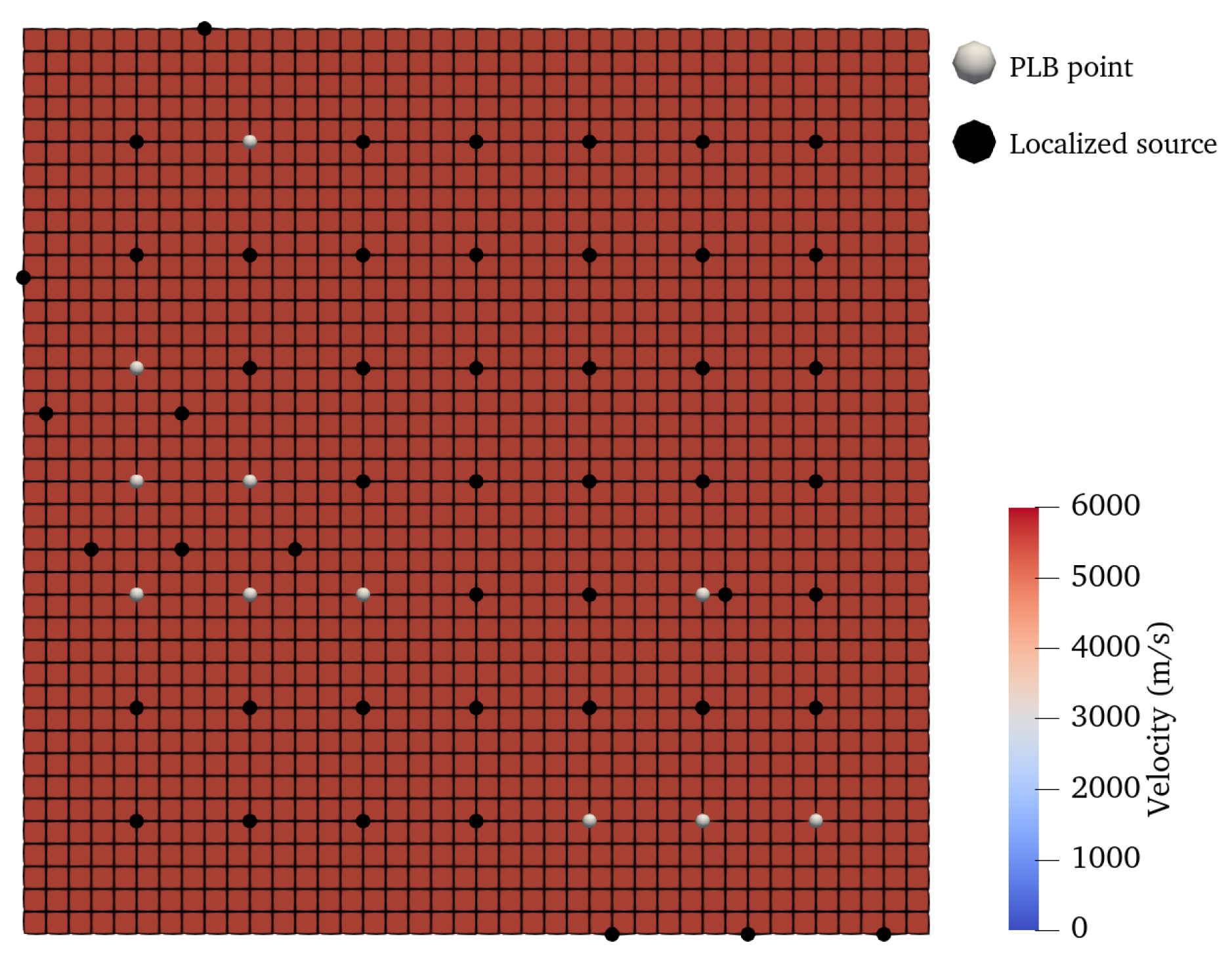

| Operating frequency (kHz) | 35–100 |
| Preamplifier gain (dB) | 40 |
| Sampling frequency (MHz) | 2 |
| Threshold of measurement trigger (dB) | 55 |
| Pre-trigger time (µs) | 256 |
| Wavelength (µs) | 511.5 |
| Classifications | Velocity Distributions | Events Used | Number of PLB Tests | Maximum Errors (mm) | Average of Errors (mm) | Number of Accurate Sources |
|---|---|---|---|---|---|---|
| Non-classification | Heterogeneous | 54 | 49 | 220 | 90 | 9 |
| SOM | Heterogeneous | 49 | 49 | 130 | 19 | 38 |
| SOM | Homogeneous | 49 | 49 | 130 | 20 | 38 |
| Velocity Distribution | Actual PLB Points (mm) | Localized Sources (mm) | Maximum Errors (mm) | Number of Sensors | The Diffraction Wave Arrival | ||
|---|---|---|---|---|---|---|---|
| X | Y | X | Y | ||||
| Heterogeneous | 700 | 100 | 780 | 0 | 130 | 6 | Ch5, Ch7 |
| Homogeneous | 100 | 500 | 0 | 580 | 130 | 12 | Ch4 |
Disclaimer/Publisher’s Note: The statements, opinions and data contained in all publications are solely those of the individual author(s) and contributor(s) and not of MDPI and/or the editor(s). MDPI and/or the editor(s) disclaim responsibility for any injury to people or property resulting from any ideas, methods, instructions or products referred to in the content. |
© 2023 by the authors. Licensee MDPI, Basel, Switzerland. This article is an open access article distributed under the terms and conditions of the Creative Commons Attribution (CC BY) license (https://creativecommons.org/licenses/by/4.0/).
Share and Cite
Nakamura, K.; Kobayashi, Y.; Oda, K.; Shigemura, S. Classification of Elastic Wave for Non-Destructive Inspections Based on Self-Organizing Map. Sustainability 2023, 15, 4846. https://doi.org/10.3390/su15064846
Nakamura K, Kobayashi Y, Oda K, Shigemura S. Classification of Elastic Wave for Non-Destructive Inspections Based on Self-Organizing Map. Sustainability. 2023; 15(6):4846. https://doi.org/10.3390/su15064846
Chicago/Turabian StyleNakamura, Katsuya, Yoshikazu Kobayashi, Kenichi Oda, and Satoshi Shigemura. 2023. "Classification of Elastic Wave for Non-Destructive Inspections Based on Self-Organizing Map" Sustainability 15, no. 6: 4846. https://doi.org/10.3390/su15064846
APA StyleNakamura, K., Kobayashi, Y., Oda, K., & Shigemura, S. (2023). Classification of Elastic Wave for Non-Destructive Inspections Based on Self-Organizing Map. Sustainability, 15(6), 4846. https://doi.org/10.3390/su15064846








